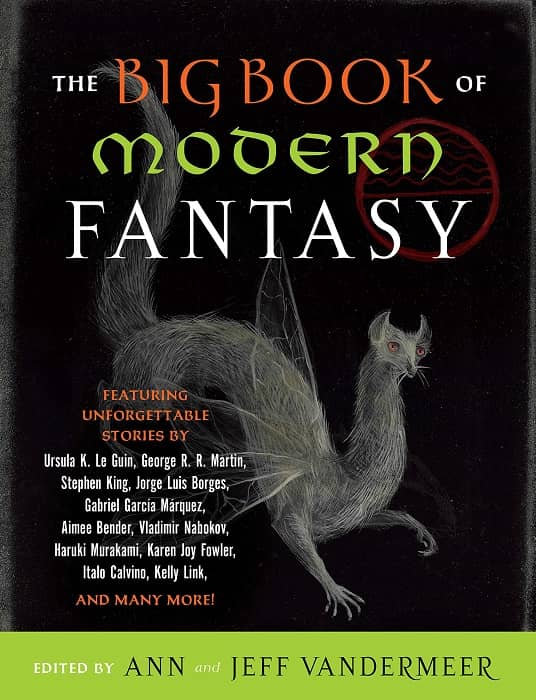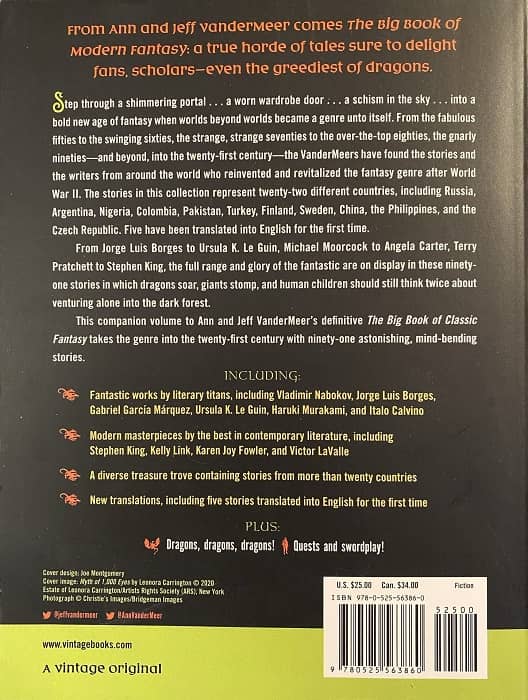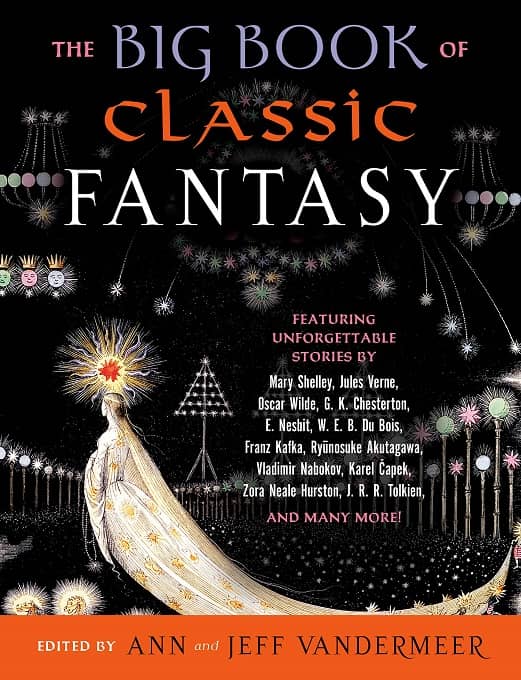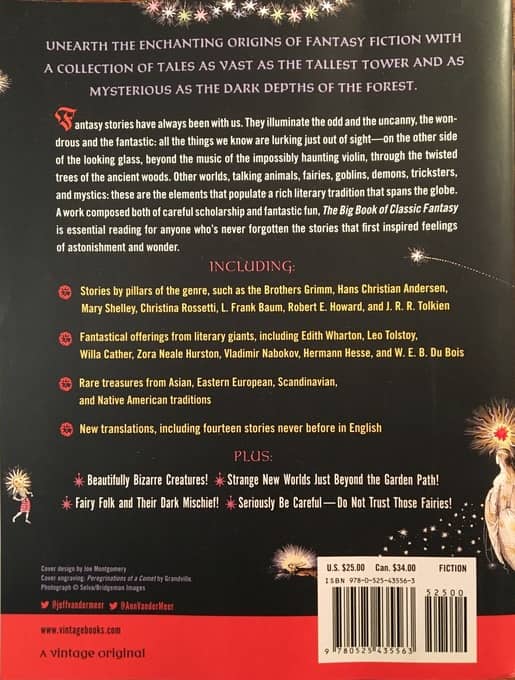New Treasures: The Big Book of Modern Fantasy edited by Ann and Jeff VanderMeer
 |
 |
Cover art by Leonora Carrington
Here we are at the end of the year, that time when book bloggers create Best of the Year lists. I’m not sure I have the ambition to create a Top Ten list, but at the very least I have a favorite anthology for 2020: The Big Book of Modern Fantasy, edited by Ann and Jeff VanderMeer, the follow-up to the magnificent Big Book of Classic Fantasy. That volume included selections up the end of World War II; this one contains 91 stories published between 1946 and 2010.
And what a rich assortment of old favorites and new discoveries it is. Here’s an excerpt from Paul Di Filippo’s delightfully detailed review at Locus Online.
Over 800 pages of bliss-inducing non-mimetic goodness which attempts the impossible: to limn the full dimensions of the unreal in today’s literature… Rounding out the first decade is Borges’s “The Zahir”, with its cursed coin that preempts all other thoughts… Moving into the 1950s… we enjoy Gabriel García Márquez’s “A Very Old Man with Enormous Wings.” Its portrait of an anomalous derelict who hovers between mortal and angel is touching. And we note that even when the editors select a famous name, they dip into the less-well-known stuff.
As the editors say in their intro, they like to break down barriers between “high” art and popular art, so seeing Fritz Leiber consorting with Márquez and Borges is a delight. His “Lean Times in Lankhmar” is a great choice since it shows us his famous companionable heroes, Fafhrd and the Gray Mouser, separate and at odds.
How better to kick off the 1960s than with Michael Moorcock’s “The Dreaming City”, the debut of Elric of Melniboné. Sixty subsequent years have not staled its lush and droll decadence. Tove Jansson’s “The Last Dragon in the World,” a sweet but not saccharine Moomintroll adventure, illustrates the tenacity of the VanderMeers in going farther afield with their net, and not remaining in easy Anglo-American territory. Lafferty’s “Narrow Valley” brings in the slapstick, tall-tale elements of fantasy which are sometimes slighted in favor of more finely hewn, even “academic” art…
Such powerhouses as George R.R. Martin, Stephen King, and Jane Yolen guide us into the Eighties, but my two favorites here are from smaller stars, and more understated. In “The Luck in the Head,” M. John Harrison charts the adventures of hapless poet Ardwick Crome, who lives in the bedazzling city of Uroconium, showing us MJH’s influence on China Miéville and, ahem, also on a certain J. VanderMeer. And Rachel Pollack gives us a fairy tale engaged with inequality in “The Girl Who Went to the Rich Neighborhood.”
As Paul points out so adroitly in his review, there’s a great many riches to be had here, even for the most well-read fantasy fan.
And on the very slim chance that you already have an encyclopedic knowledge and appreciation of modern fantasy, you can instead enjoy the previous book in the sequence, last year’s Big Book of Classic Fantasy.
 |
 |
Cover engraving Peregrinations of a Comet by Grandville
Still not sold? The editors gave a enticing preview of the new book at LitHub that first piqued my interest.
Many of these tales reboot or update the idea of the folktale or fairytale while grappling with modern issues. For example, Argentine writer Sara Gallardo’s “The Great Night of Trains” features characters that are trains, but is really about revolution. And not to be outdone, on the talking creature side, a real gem like Guyanese writer Edgar Mitteholzer’s “Poolwana’s Orchid” isn’t just about insects and plants that converse. It’s about prejudice, greed regret, and friendship.
As anthologists covering wide subjects like “fantasy,” you want your stories to have weight, you want them to mean something. To be relevant to a modern audience when possible. But another anchor is, of course, the sheer sense of play that pervades many of these tales. Maurice Richardson’s “Ten Rounds with Grandfather Clock” is, although tinged with satire, at heart just simply a surrealist hilarity about a boxing match with a clock. Does it need to be more? Or Terry Pratchett’s “Troll Bridge,” which takes a humorous (but loving) jab at the entire fairy tale genre.
Some stories you become so fond of you just love them unconditionally by the end of the process. Most of them are stories that held up to your re-reads over and over, while revealing something new every time. “The Youngest Doll” by Puerto Rican writer Rosario Ferré, is a cautionary story told in a manner familiar to readers of fairy tales. Published almost five decades ago, it still resonates today with its commentary on women’s rights and income equality.
“Five Letters From an Eastern Empire,” by Scottish writer Alasdair Gray is playful in its telling, yet biting in the satire in how it portrays government officials and organized religion. Ramsey Shehadeh’s “Creature” is a favorite of ours, introducing a horrifying yet friendly monster, described so joyfully, who takes a young girl under their protection and helps her navigate through a post-apocalyptic future amid the destruction perpetrated by humankind.
The truth is, a book of modern fantasy is a treasure trove of marvels, a cabinet of curiosities, and, perhaps more importantly, a strong, strong testimony to the importance of imaginative literature, of non-realist literature, and of traditions other than the Anglo Saxon.
Here’s the impressive Table of Contents.
Dean Francis Alfar, “The Kite of Stars” (Philippines
Erik Amundsen, “Bufo Rex”
J.G. Ballard, “The Drowned Giant”
Nathan Ballingrud, “The Malady of Ghostly Cities”
Greg Bear, “The White Horse Child”
Aimee Bender, “End of the Line”
Jorge Luis Borges, “The Zahir” (Argentina), translated by Andrew Hurley
Richard Bowes, “The Bear Dresser’s Secret”
Paul Bowles, “The Circular Valley”
Mikhail Bulgakov, “The Sinister Apartment” (Ukraine), translated by Ekaterina Sedia
Italo Calvino, “The Origins of the Birds” (Italy), translated by William Weaver
Leonora Carrington, “A Mexican Fairy Tale” (UK/Mexico)
Angela Carter, “Alice in Prague or The Curious Room”
Angela Carter, “The Erl-King”
Stepan Chapman, “State Secrets of Aphasia”
Fred Chappell, “Linnaeus Forgets”
C.J. Cherryh, “The Dreamstone”
Alberto Chimal, “Mogo” (Mexico), translated by Lawrence Schimel
Alberto Chimal, “Table with Ocean” (Mexico), translated by Lawrence Schimel
Julio Cortázar, “Cronopios and Famas” (Argentina), translated by Paul Blackburn
Samuel R. Delany, “The Tale of Dragons and Dreamers”
Manuela Draeger, “The Arrest of the Great Mimille” (France), translated by Brian Evenson and Valerie Mariana
David Drake, “The Fool”
Rikki Ducornet, “The Neurosis of Containment”
Henry Dumas, “Ark of Bones”
Carol Emshwiller, “Moon Songs”
Musharraf Ali Farooqi, “The Jinn Darazgosh: A Qissa” (Pakistan)
Rosario Ferré, “The Youngest Doll” (Puerto Rico), translated by Rosario Ferré and Diana Vélez
Jeffrey Ford, “The Weight of Words”
Karen Joy Fowler, “Wild Boys: Variations on a Theme”
Sara Gallardo, “The Great Night of the Trains” (Argentina), translated by Jessica Sequiera
Alasdair Gray, “Five Letters From an Eastern Empire”
Elizabeth Hand, “The Boy in the Tree”
M. John Harrison, “The Luck in the Head”
Zenna Henderson, “The Anything Box”
Marie Hermanson, “The Mole King” (Sweden), translated by Charlie Haldén
Joe Hill, Pop Art
Nalo Hopkinson, “Tan-Tan and Dry Bone” (Canada)
Rhys Hughes, “The Darktree Wheel”
Intizar Husain, “Kaaya-Kalp (or Metamorphosis)” (Pakistan), translated by C. M. Naim
Shelley Jackson, “Foetus”
Tove Jansson, “The Last Dragon in the World” (Finland), translated by Thomas Warburton
Diana Wynne Jones, “Warlock at the Wheel”
Vilma Kadlečková, “Longing for Blood” (Czech Republic), translated by Martin Klima and Bruce Sterling
Bilge Karasu, “The Prey” (Turkey), translated by Aron Aji
Caitlín R. Kiernan, “La Peau Verte”
Stephen King, “Mrs Todd’s Shortcut”
Marta Kisiel, “For Life” (Poland), translated by Kate Webster
Leena Krohn, “The Bystander” (Finland), translated by Hildi Hawkins
R.A. Lafferty, “Narrow Valley”
Victor LaValle, “I Left My Heart in Skaftafell”
Tanith Lee, “Where Does the Town Go At Night”
Ursula K. Le Guin, “The Ones Who Walk Away from Omelas”
Fritz Leiber, “Lean Times in Lankhmar”
D.F. Lewis, “A Brief Visit to Bonnyville”
Kelly Link, “Travels with the Snow Queen”
Rochita Loenen-Ruiz, “The Wordeaters” (Philippines/Netherlands)
Gabriel García Márquez, “A Very Old Man with Enormous Wings” (Colombia), translated by Gregory Rabassa
George R.R. Martin, “The Ice Dragon”
Patricia McKillip, “The Fellowship of the Dragon”
Edgar Mittelholzer, “Poolwana’s Orchid” (Guyana)
Michael Moorcock, “The Dreaming City”
Haruki Murakami, “TV People” (Japan), translated by Alfred Birnbaum
Pat Murphy, “On the Dark Side of the Station Where the Train Never Stops”
Vladimir Nabokov, “Signs and Symbols” (Russia)
Garth Nix, “Beyond the Sea Gate of the Scholar Pirates of Sarsköe” (Australia)
Silvina Ocampo, “The Topless Tower” (Argentina), translated by James and Marian Womack
Ben Okri, “What the Tapster Saw” (Nigeria)
Victor Pelevin, “The Life and Adventures of Shed XII” (Russia), Translated by Andrew Bromfield
Rachel Pollack, “The Girl Who Went to the Rich Neighborhood”
Sumanth Prabhaker, “A Hard Truth About Waste Management”
Terry Pratchett, “Troll Bridge”
Qitongren, “The Spring of Dongke Temple” (China), Translated by Liu Jue
Maurice Richardson, “Ten Rounds with Grandfather Clock”
Joanna Russ, “The Barbarian”
Edgardo Sanabria Santaliz, “After the Hurricane” (Puerto Rico), translated by Beth Baugh
Ramsey Shehadeh, “Creature”
Leslie Marmon Silko, “One Time” (poem)
Han Song, “All the Water in the World” (China), translated by Anna Holmwood
Margaret St. Clair, “The Man Who Sold Rope to the Gnoles”
Avrom Sutzkever, “The Gopherwood Box” (Belarus), translated by Zackary Sholem Berger
Antonio Tabucchi, “The Flying Creatures of Fra Angelico” (Italy), translated by Tim Parks
Sheree Renée Thomas, “The Grassdreaming Tree”
Karin Tidbeck, “Aunts” (Sweden), translated by the author
Tatiana Tolstaya, “The Window” (Russia), translated by Anya Migdal
Amos Tutuola, excerpt from “My Life in the Bush of Ghosts” (Nigeria)
Jack Vance, “Liane the Wayfarer”
Satu Waltari, “The Monster” (Finland), translated by David Hackston
Sylvia Townsend Warner, “Winged Creatures”
Manly Wade Wellman, “O Ugly Bird”
Jane Yolen, “Sister Light, Sister Dark”
Taken together, the Vintage Books Big Books imprint is an impressive library of pup and genre fiction. Most of them are still in print in oversized, economical trade paperback editions, and they get my highest recommendation. They are:
The Black Lizard Big Book of Pulps — 2007
The Vampire Archives — 2009
The Black Lizard Big Book of Black Mask Stories — 2010
Zombies! Zombies! Zombies! — 2011
The Big Book of Adventure Stories — 2011
The Big Book of Ghost Stories — 2012
The Big Book of Christmas Mysteries — 2013
The Black Lizard Big Book of Locked-Room Mysteries — 2014
The Big Book of Sherlock Holmes Stories — 2015
The Big Book of Jack the Ripper — 2016
The Big Book of Science Fiction — 2016
The Big Book of Rogues and Villains –- 2017
The Big Book of Female Detectives — 2018
The Big Book of Classic Fantasy — 2019
The Big Book of Modern Fantasy was published by Vintage Books on July 21. 2020. It is 896 pages, priced at $25 in trade paperback and $12.99 in digital formats. The cover art is by Leonora Carrington, who also contributes a story.
See all our recent New Treasures here.
I still need to start reading these VanderMeer anthologies. Which should keep me busy for possibly the rest of my life?
Although the dream will always be a Big Book of-sized anthology specifically of sword & sorcery.
And also a digital reprint of David G. Hartwell’s The Dark Descent.
I have to clear more shelf space? Damn.
Carroll & Graf used to do some nice anthologies in their “Mammoth” series. They weren’t as sexy as these Vandermeer books, but they were six to seven hundred pages of great reading. I have three whopping C&G ghost story books that I’ll probably never make my way through.
I remembered when I reviewed their huge weird volume a few years ago. That volume was from Tor though. I wonder why Tor didn’t continue them? These have obviously been a hit.
i havent seen how they put together these big books yet, but a feature i wish they could add to all anthologies is a mini bibliography for the author after each story, because many times i finish a story i like a lot and want to know what else they have put out, but am already in bed, and by the next day i forget or end up not looking them up. i dont know how feasable that is with page count or if anthologies already do this. think i might pick up these in digital format.
Wow! Very impressive anthology